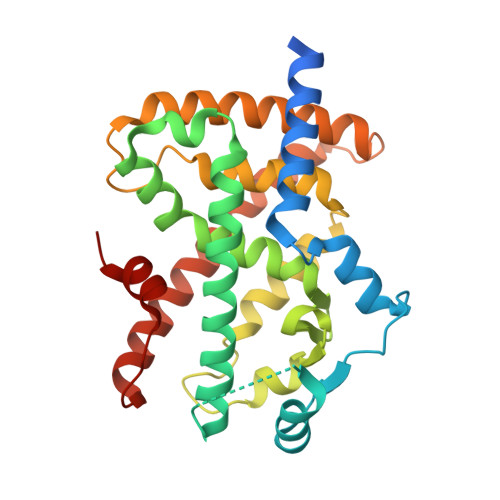Structures of PPAR gamma complexed with lobeglitazone and pioglitazone reveal key determinants for the recognition of antidiabetic drugs
Lee, M.A., Tan, L., Yang, H., Im, Y.G., Im, Y.J.(2017) Sci Rep 7: 16837-16837
- PubMed: 29203903
- DOI: https://doi.org/10.1038/s41598-017-17082-x
- Primary Citation of Related Structures:
5Y2O, 5Y2T - PubMed Abstract:
Peroxisome proliferator-activator receptor (PPAR) ¦Ã is a nuclear hormone receptor that regulates glucose homeostasis, lipid metabolism, and adipocyte function. PPAR¦Ã is a target for thiazolidinedione (TZD) class of drugs which are widely used for the treatment of type 2 diabetes. Recently, lobeglitazone was developed as a highly effective TZD with reduced side effects by Chong Kun Dang Pharmaceuticals. To identify the structural determinants for the high potency of lobeglitazone as a PPAR¦Ã agonist, we determined the crystal structures of the PPAR¦Ã ligand binding domain (LBD) in complex with lobeglitazone and pioglitazone at 1.7 and 1.8?? resolutions, respectively. Comparison of ligand-bound PPAR¦Ã structures revealed that the binding modes of TZDs are well conserved. The TZD head group forms hydrogen bonds with the polar residues in the AF-2 pocket and helix 12, stabilizing the active conformation of the LBD. The unique p-methoxyphenoxy group of lobeglitazone makes additional hydrophobic contacts with the ¦¸-pocket. Docking analysis using the structures of TZD-bound PPAR¦Ã suggested that lobeglitazone displays 12 times higher affinity to PPAR¦Ã compared to rosiglitazone and pioglitazone. This structural difference correlates with the enhanced affinity and the low effective dose of lobeglitazone compared to the other TZDs.
Organizational Affiliation:
College of Pharmacy, Chonnam National University, Gwangju, 61186, Republic of Korea.

















